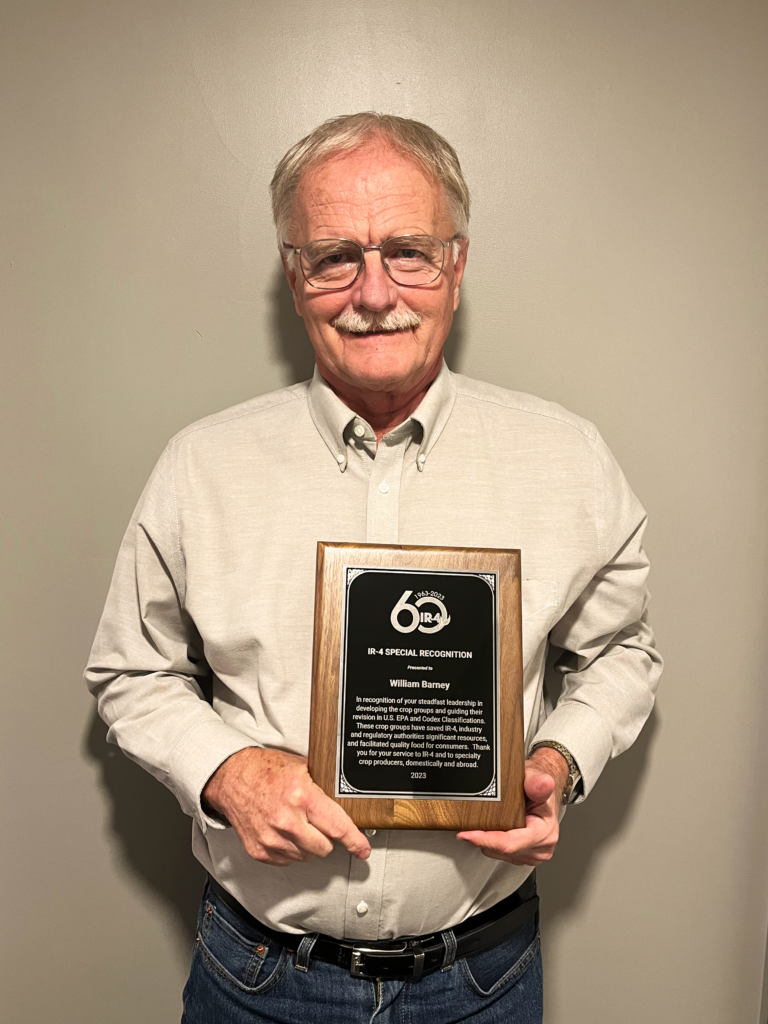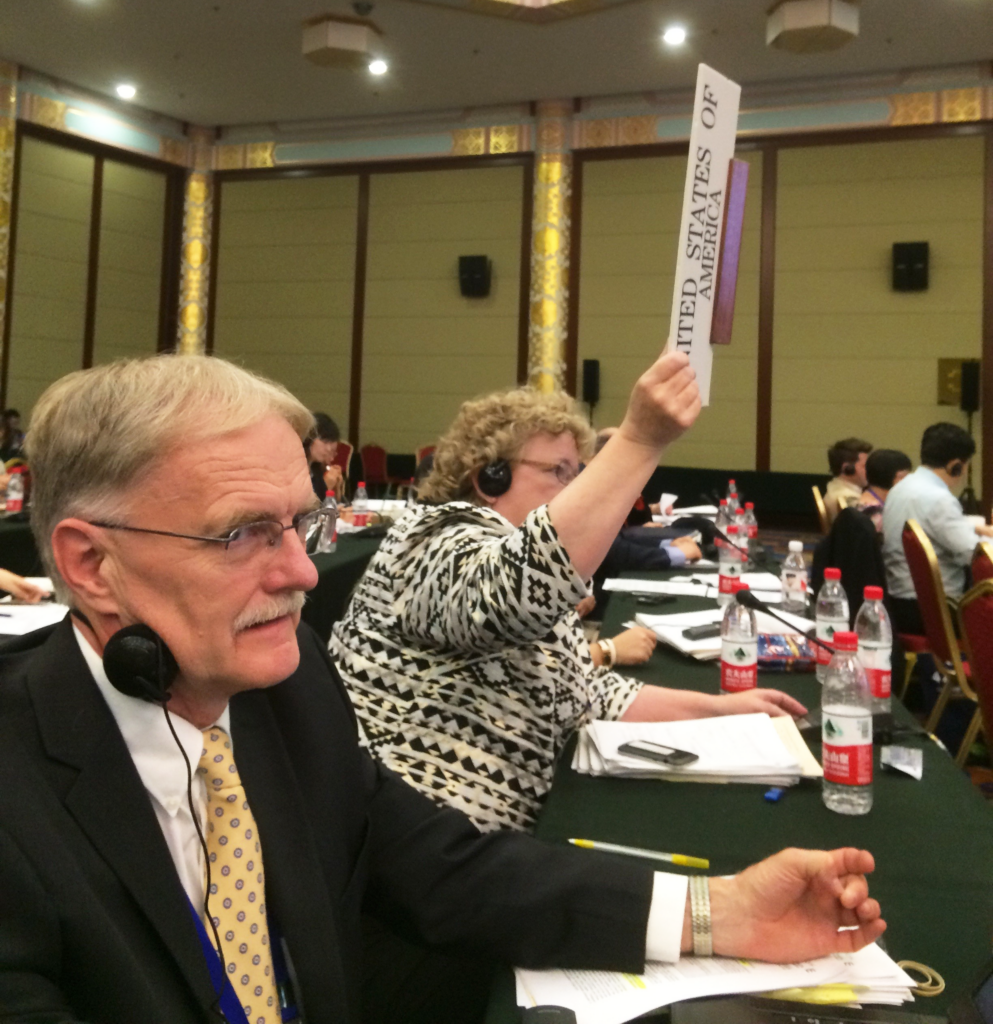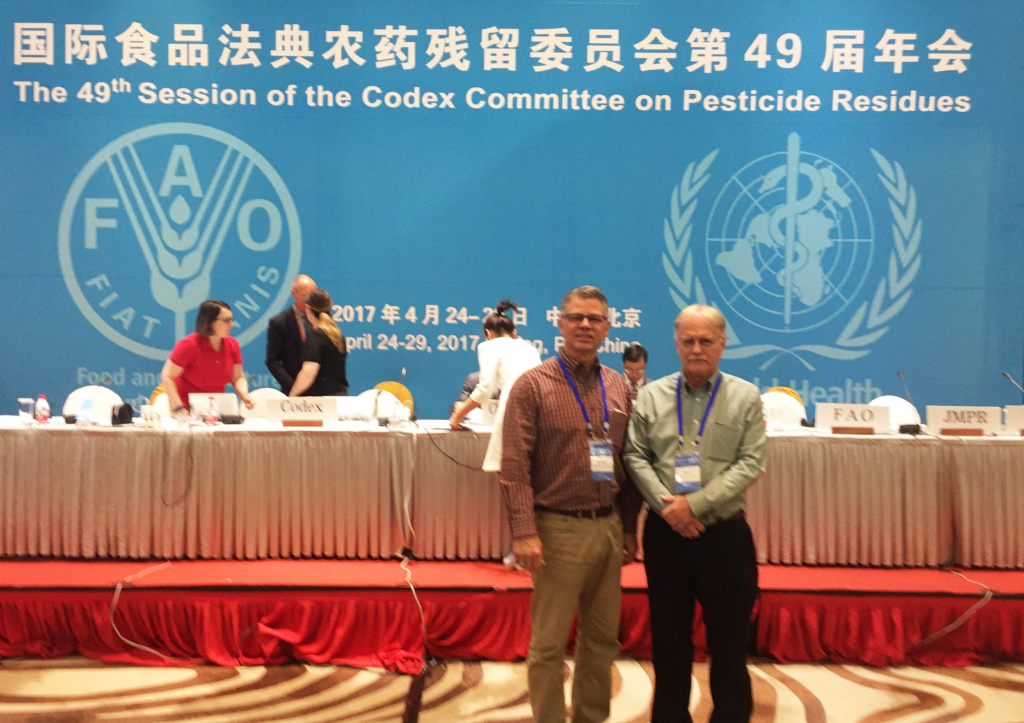Building Upon U.S. Framework, International Crop Groups Now Revised
 At the 2023 Food Use Workshop, IR-4 recognized Bill Barney with a special award celebrating his leadership in the now finalized revision (pending approval of the Codex Alimentarius Commission) of the Codex Classification of Foods and Animal Feeds (CXA 4-1989). This is a tremendous milestone for Barney, for IR-4, and for global agricultural trade.
At the 2023 Food Use Workshop, IR-4 recognized Bill Barney with a special award celebrating his leadership in the now finalized revision (pending approval of the Codex Alimentarius Commission) of the Codex Classification of Foods and Animal Feeds (CXA 4-1989). This is a tremendous milestone for Barney, for IR-4, and for global agricultural trade.
After systematically working with international collaborators on the multiyear project of revising the Codex crop groups, Barney helped guide the effort to successful completion at the 54th Session of the Codex Committee on Pesticide Residues (CCPR54), which met in Beijing, China from June 26-July 1, 2023.
Barney, IR-4’s Biopesticide Regulatory Manager, was a key leader in the U.S. crop grouping effort and brought this experience to the international stage as chair of the CCPR’s electronic working group (EWG). Even prior to Barney’s involvement, IR-4 led the development of extrapolation models that fostered the establishment of the U.S. crop groups.
“Bill’s work continues the IR-4’s legacy of leadership in crop grouping expansion,” said Jerry Baron, Executive Director of The IR-4 Project. Baron added, “Professor George Markle, former IR-4 Associate Director and lead author of Food and Feed Crops of the United States, is credited with the development of the concept of the newest crop grouping scheme.”
Building upon IR-4’s foundational work in the U.S. to bring the crop grouping concept to Codex has required diligent documentation and collaboration. Between each annual session of the CCPR, member countries worked to reconcile comments and address concerns across the globe in order to move the revisions forward. Leadership from the U.S. and the Netherlands helped to keep the EWG (including more than 150 member countries) on track.
This completed revision “really helps the efficiency of the residue studies that are conducted,” explained Barney. Codex recommends residue limits and then the Joint Meeting on Pesticide Residues (JMPR) reviews the data; submissions for MRLs can now be set for a group of crops rather than an individual crop, which is very similar to the U.S. system. Beyond regulatory efficiency, revising the Codex crop groups helps ensure fair agricultural trade practices, benefiting growers and consumers.
Gaining Ground towards Global Harmonization

Barney noted that reaching international consensus on the crop groups wasn’t a simple task. Each country will always advocate for their growers, consumers, and import/export market. While international harmonization is the goal, in reality, it’s a challenge.
“A good example is quinoa, which the U.S. wanted to include in the wheat subgroup,” explained Barney. “But the EU wanted to include it as a completely separate subgroup, which means it would be difficult to get MRLs for quinoa…it’s a very minor crop and companies would not spend the money to do the residue studies that were needed.”
The varied agricultural markets of each country also informed their perspectives on what made the most sense as the “representative” crop for a given group. For example, while the U.S. suggested broccoli as the representative Brassica, India advocated for cauliflower—a key crop in that country. The committee found a way to accommodate differing viewpoints by agreeing on alternate representative crops where they made sense (such as broccoli and/or cauliflower), making room for climatic and cultural differences.
The key criteria for a representative crop include: one that is most likely to have the highest residue; one that is economically important; and one that is similar in morphology and production to other members of the group.
IR-4 Documentation Lays Foundation for Codex Success
Mary Frances Lowe, U.S. Manager for Codex Alimentarius, highlighted in a letter to Barney that, “much of the necessary documentation used to support revision of the proposed crop groups came from the United States and the IR-4 Project.”
This necessary documentation emerged from the proposals developed through IR-4-led efforts to revise the U.S. crop groups. While international work always generates differences of opinion and conflicting perspectives, the groundwork provided by this U.S. documentation helped to move the process along in a timely manner.
“We had an International Crop Grouping Consulting Committee and they would provide additional crops to add to the revised U.S. groups,” explained Barney. “We also wrote monographs for each of the crops and then the U.S. revised groups were kind of used as a basis to revise the Codex crop groups. Essentially, IR-4 provided a lot of information to the effort.”
The Leader Codex Needed

Dan Kunkel, former IR-4 Associate Director for Food and International Programs, collaborated with Barney for many years on U.S. and international crop grouping efforts. Kunkel attended CCPR meetings as a member of the U.S. delegation during his time at IR-4, and recalls a critical moment when the Netherlands’s chair was ill and withdrew from an upcoming meeting. Kunkel knew that leadership was sorely needed from the committee, and saw that Barney had the ideal skillset to fit the role:
After the Netherlands could no longer lead the CCPR crop group classification effort (around 2013), nor lead the discussions at the meeting, it was immediately apparent to me that Bill Barney needed to join (in person) at the meeting, otherwise the effort may fail. Bill’s technical expertise, along with his mild demeanor and cooperative attitude, won committee support throughout the Codex crop group effort. There is no doubt in my mind that an effort that has saved (and will save) so many resources (at so many levels) would have been delayed many years—or failed—if Bill did not take over to lead the effort as Chair on the behalf of the US government.
Barney’s involvement in the CCPR gave him the opportunity to travel to China on multiple occasions, visiting the Great Wall and other awe-inspiring landmarks. Recalling the Great Wall Barney noted, “I can’t imagine the labor that went into building that—it’s pretty incredible.”
While it’s no Great Wall, the latest Codex revision and Barney’s labor to bring it to fruition is a remarkable feat. IR-4 extends our heartfelt gratitude and congratulations to Bill on a job well done!

About The IR-4 Project
The mission of the IR-4 Project is to facilitate regulatory approval of sustainable pest management technologies for specialty crops and specialty uses to promote public well-being. By working directly with local crop growers across the country, IR-4 conducts research and develops data necessary for the registration of pest management tools, ensuring that they are safe for use. To learn more, visit our website.
